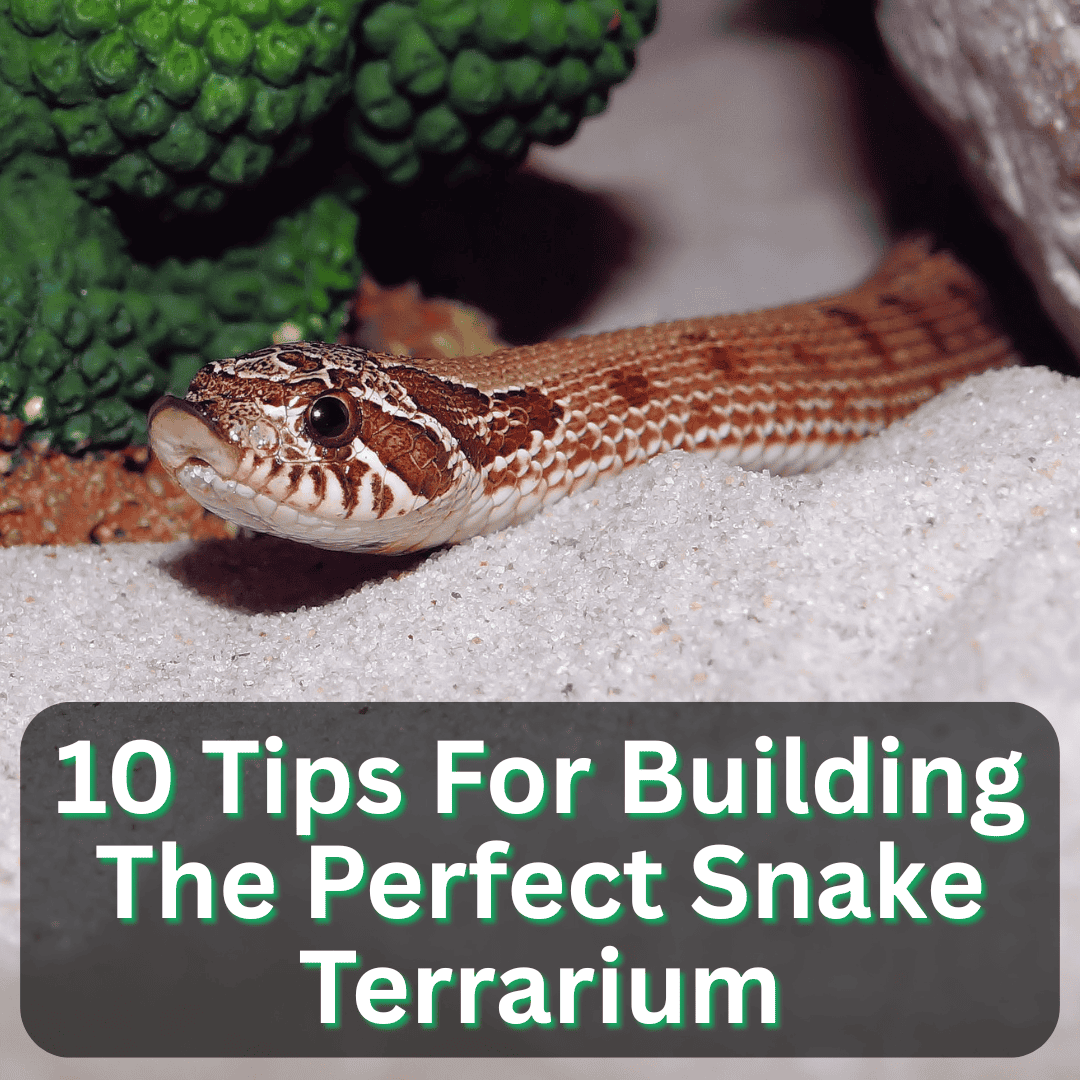
But it’s not as complicated as it looks, though it does take some work.
It’s worth it though. Your snake deserves a home that keeps it healthy and relaxed.
The right terrarium setup can really mean the difference between a stressed snake and a thriving pet.
Building the perfect snake home is all about nailing the basics.
Think about tank size, temperature, humidity, safe hiding spots, and the right flooring.
With a little planning and the right gear, you’ll have a space where your snake feels secure and comfortable.
Tips For Building The Perfect Snake Terrarium
Setting up a habitat incorrectly is a common mistake among new snake owners. Follow the tips below to ensure you give your pet snake a habitat where it can feel comfortable and stay healthy and happy.
1. Choose A Tank At Least Twice Your Snake’s Length
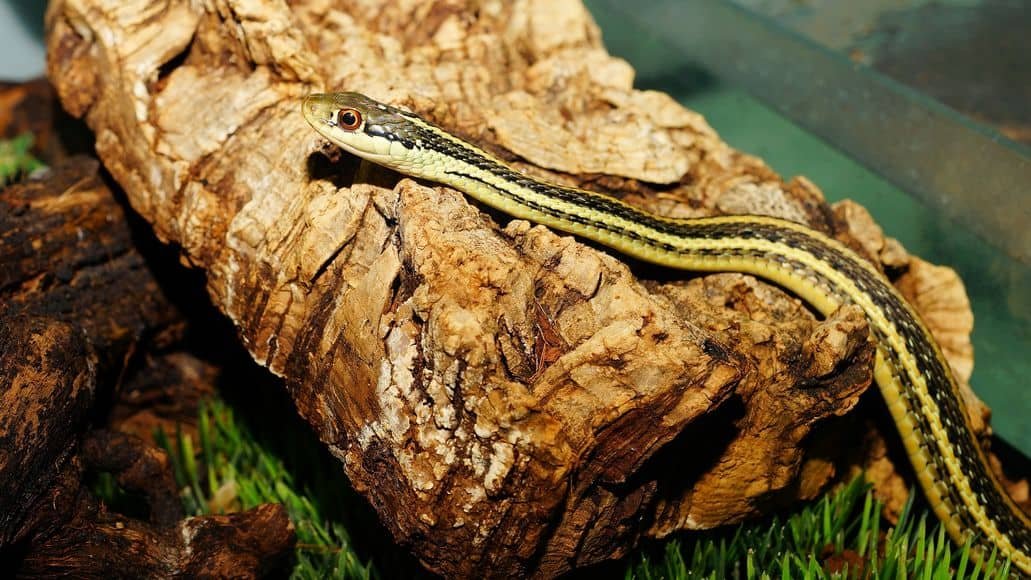
The golden rule for tank size? Simple: your snake’s enclosure should be at least twice as long as your snake’s adult length. Measure from head to tail. Got a 3-foot snake? You’re looking at a 6-foot-long tank, minimum.
This gives your snake room to stretch out and explore. Movement is key for their health and happiness. Plan ahead for growth—young snakes don’t stay small. Check your snake’s adult size before you commit to a tank.
Some people recommend a tank that lets your snake stretch along two sides: so a 3-foot snake might need a tank 3 feet long and 1.5 feet wide at least. Bigger tanks are almost always better. More space, less stress.
Different species, different needs. Ball pythons and corn snakes might need different setups even if they’re the same length. Active snakes? They’ll want more room. Less active ones can get by with the basics. Climbers should have plenty of vertical space so they can actually indulge their climbing hobby.
2. Use Thermostat-Controlled Heat Pads For Consistent Temperature
Heat pads can be risky if you use them alone—they might get too hot and burn your snake. A thermostat keeps the heat pad at a safe, steady temperature. You just set it and let it do its thing.
Stick the heat pad under the tank and put the thermostat probe between the mat and the glass bottom. Different snake species have different temperature needs, so make sure you research what your snake needs.
Then set your thermostats on the warm side and the cool side to the ideal temperatures for your species. A temperature gun helps you check the real surface temperature, so you’re not just guessing.
Never run heat pads without a thermostat. Spikes in temperature can really hurt your snake. Each heat pad should have its own thermostat for the best control. That way, you can fine-tune as needed.
3. Install A Reliable Hygrometer To Monitor Humidity Levels
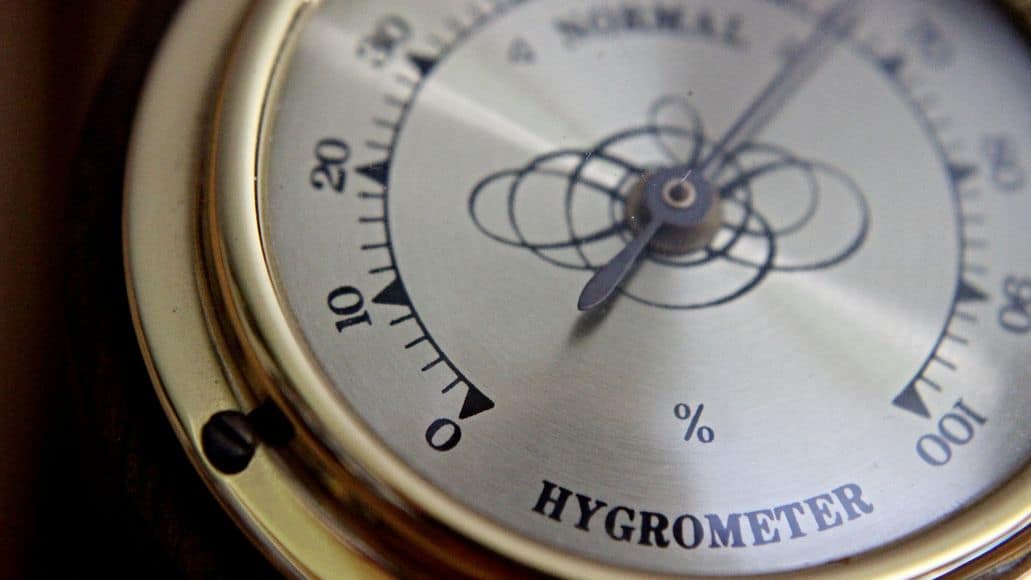
You’ll want a solid hygrometer to keep tabs on humidity. Digital models tend to be more accurate than the cheap stick-on ones. Set your hygrometer on the substrate in the middle of the enclosure, or part-way up the side for a solid average reading.
Check it regularly to make sure humidity stays in your snake’s comfort zone. Their health really depends on it.
Some digital indoor-outdoor thermometers also show humidity and come with wireless probes—handy if you want to monitor multiple spots. Put the gauge where your snake hangs out most. If they stick to the cool side, that’s where the gauge should go.
Try moving the hygrometer around for about 20 minutes in each spot. You’ll get a sense of how humidity shifts around the tank.
4. Add A Secure, Escape-proof Lid To Your Terrarium
The lid is your snake’s main security line. Snakes are notorious escape artists—if there’s a weak spot, they’ll find it. Pick a lid with strong clamps or locks. Glass tanks with screen tops need sturdy clamps, no question. If you can lift the lid with a finger, so can your snake.
Push on the lid to test it. No gaps, no loose pieces. Snakes will use their heads to probe for weaknesses. If you need to, add your own locks or clips. A little extra security never hurts. Double-check that every lock works as it should.
Screen lids need tight mesh, strong enough to hold your snake if they climb on top. No pushing through or sagging. The lid should let in fresh air, but not give your snake any escape routes. Ventilation holes need to be smaller than your snake’s head.
Check the lid for damage now and then. Plastic cracks, metal bends. Fix or replace anything that looks sketchy before it becomes a problem.
5. Use Coconut Fiber Or Aspen Shavings As Safe Substrate Options
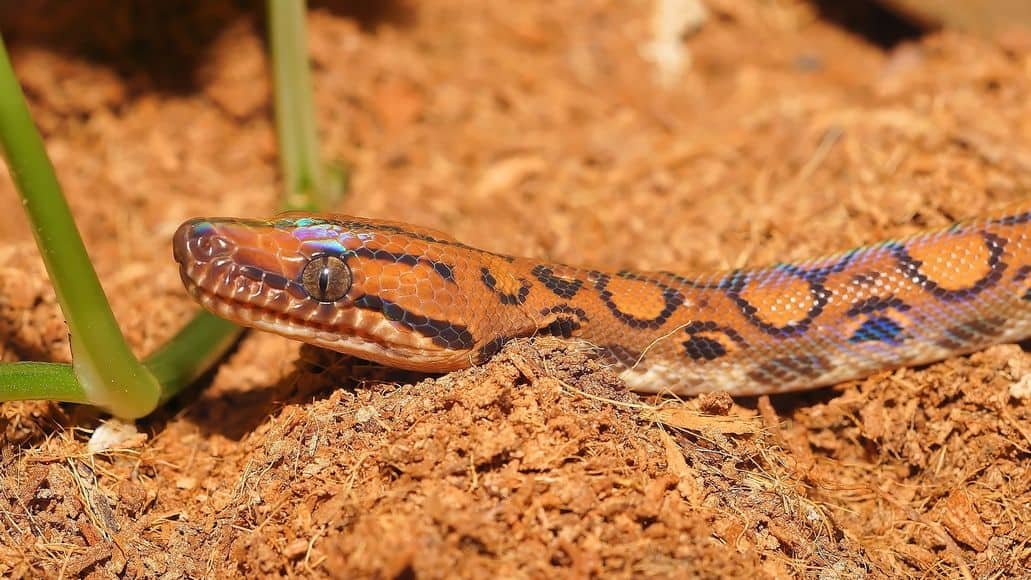
Pick a bedding that’s safe, even if your snake accidentally eats a little. Coconut fiber and aspen shavings are both solid choices for most pet snakes.
Coconut fiber holds moisture really well, which helps keep humidity stable. It’s soft and easy for snakes to dig in, too. Aspen shavings are great for burrowers and soak up waste and smells. And if your snake swallows a bit, it’s usually not a big deal.
Both are easy to spot-clean, so you don’t have to swap out all the bedding every time. Saves some hassle and cash. Stick to substrates made for reptiles. Pet store bedding is generally safe. Skip cedar or pine—those can mess with your snake’s breathing.
Mixing coconut fiber and aspen shavings? Not a bad move. You get moisture control and soft digging material together. Swap out the substrate when it starts to smell or look gross. Fresh bedding just makes for a happier snake.
6. Provide Both A Warm Basking Spot And A Cooler Area Inside
Your snake needs a temperature gradient—a warm side and a cool side—to regulate its body heat. Create a basking spot on one side of the terrarium. That’s where your snake can soak up extra warmth.
Use a heat mat under one side, or add a heat lamp above the basking spot if you need more heat. The basking spot is like your snake’s version of sunbathing. They’ll hang there when they want to warm up.
Keep the other side cooler so your snake can cool off if it gets too warm. Snakes move between these areas as they need. It’s how they manage their body temperature.
Aim for about a 10-degree difference between the warm and cool sides. Check what your snake’s species actually prefers.
7. Include Natural Hides For Your Snake To Feel Safe
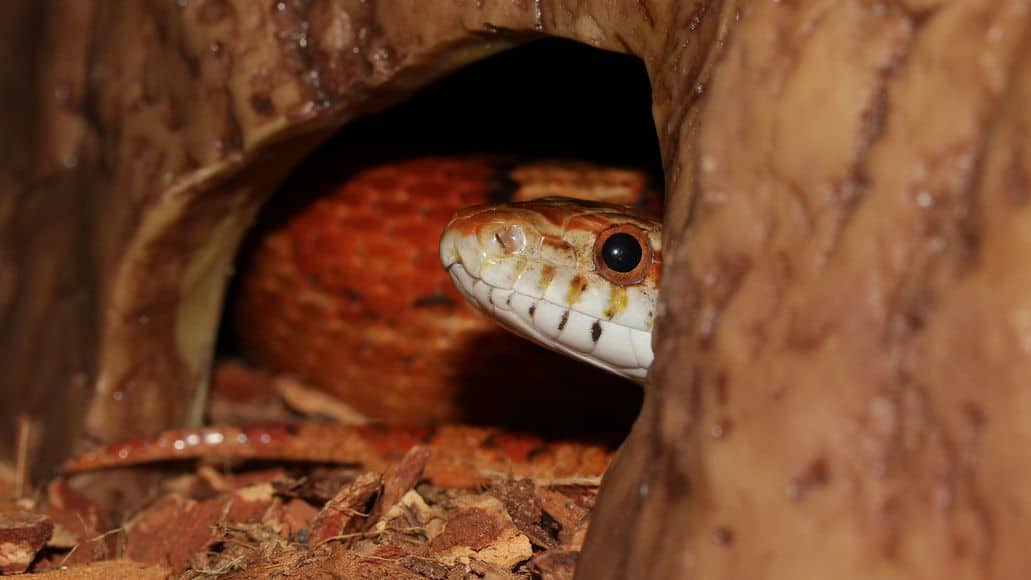
Hiding spots are a must. In the wild, snakes duck under rocks, logs, and into burrows to stay safe. Give your snake at least two hides—one on the warm side, one on the cool side.
You can buy hides or make your own. Cork bark, hollow logs, rocks—just make sure they’re clean and safe. The hide should be snug, not huge. Too big, and your snake won’t feel secure. Too small, and they won’t fit comfortably.
Keep the entrance low and wide enough for easy access. Your snake should be able to curl up fully inside. Make sure hides won’t tip over. Heavy stone or ceramic hides work well. Skip anything with sharp corners. Give the hides a regular clean to keep out bacteria and mold. Healthy snake, happy snake.
8. Incorporate Branches Or Climbing Structures For Enrichment
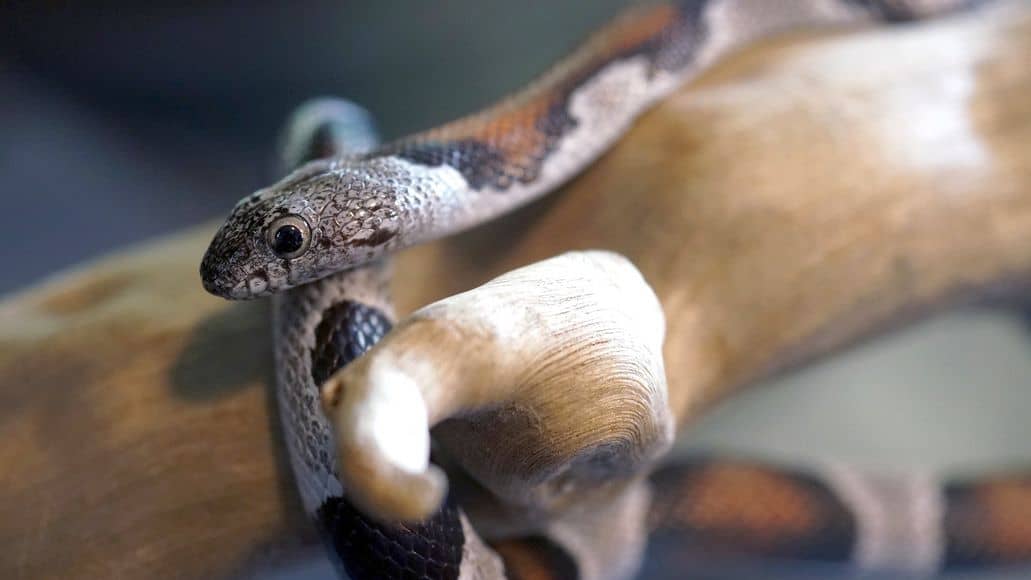
Branches and climbing structures make your snake’s home way more interesting. They mimic natural features and give your snake stuff to do. Pick sturdy branches that can handle your snake’s full weight. Wobbly or weak branches are just asking for trouble.
Real wood or fake reptile branches both work. If you use real wood, give it a good clean and check for rough spots. Set branches at different angles and heights. Some snakes love to lounge up high rather than on the ground.
Arboreal species want more climbing options, so focus on vertical space if you’ve got a tree-dweller. More branches and platforms higher up make a difference for snake species that are excellent climbers.
Just make sure branches don’t block heat sources or lights. Test everything for stability before letting your snake loose in there.
9. Use UVB Lighting If Recommended For Your Snake Species
Some snakes need UVB lighting, while others get by without it. Still, a lot of snakes benefit from a bit of UVB for bone health and general wellness. UVB helps snakes process calcium, which keeps their bones strong. It can boost their immune system, too.
Check what your snake’s species needs—some diurnal (day-active) snakes need UVB more than nocturnal ones.
If you go for UVB, get a reptile-specific bulb and set it up at the right distance from the basking spot. Always follow the instructions. UVB bulbs get weaker over time, even if they still look bright. Swap them out every 6-12 months to keep the UVB output strong.
Set up a day/night cycle: 10-12 hours of UVB during the day, lights off at night so your snake can rest. Give your snake places to hide from the UVB when they want to. Hides on both sides of the tank are a good idea.
10. Clean The Terrarium Regularly To Maintain A Healthy Environment
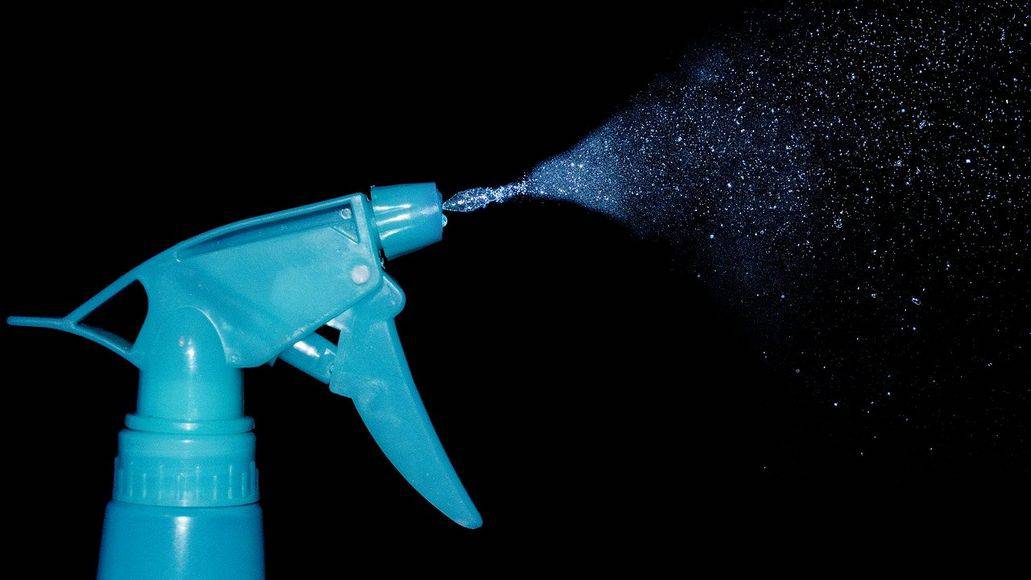
Regular cleaning is a must for a healthy terrarium. It keeps bacteria and mold at bay. Remove uneaten food within a day—old food just attracts bugs and smells bad.
Clean up waste as soon as you spot it. Use gloves, and definitely wash your hands after. Wipe down the glass once a week with a reptile-safe cleaner or just water. Clean glass looks better and lets you check on your snake more easily.
Change the water bowl every few days. Snakes sometimes use it as a bathroom, so fresh water is important. Keep an eye out for mold, especially in corners and under decorations. If you see any, clean it up right away with a safe cleaner.
Once a month, take your snake out and deep clean the whole setup. Wash all decorations and surfaces thoroughly. Spending a few minutes each week on cleaning saves you from bigger headaches down the road.
Understanding Snake Behavior And Needs
Every snake species has its own quirks and needs, based on where it comes from in the wild. If you want a relaxed, happy snake, try to match their natural habitat as much as you can and give them safe spots to hide. It’s not always perfect, but your snake will appreciate the effort.
Species-Specific Environmental Preferences
Different snake species really do have their own preferences when it comes to living conditions. Ball pythons, for example, come from warm, humid parts of Africa. They thrive with a cool side around 78 to 80° F and a basking spot that hits 88 to 92° F. It’s a pretty specific setup, honestly.
Corn snakes, on the other hand, are native to North America and prefer it a bit cooler—think 75 to 85° F. They’re not as needy with humidity either, at least compared to ball pythons.
Desert species like sand boas want:
- Low humidity (30-40%)
- Sandy substrate
- Hot basking spots (95-100° F)
Forest species like green tree pythons are pickier about moisture and need:
- High humidity (60-80%)
- Branches for climbing
- Moderate temperatures (78-88° F)
Garter snakes are super active and really appreciate extra space to roam. They also enjoy cooler temps than most other pet snakes—something to keep in mind if you’re considering one.
Honestly, it pays off to research where your snake comes from. That way, you’ll know which substrate, decorations, and climate settings actually make sense for them.
Stress Reduction Strategies
Hiding spots are a big deal for keeping snakes calm. Every snake should have at least two—one on the warm side, another on the cool side.
Some good hiding spots:
- Commercial snake hides
- Hollow logs
- Overturned flower pots
- Cork bark pieces
Pick a hide that’s just snug enough for your snake to feel secure. If it’s too roomy, they probably won’t use it.
Try to limit handling, especially after meals. Most snakes are fine with being handled just once or twice a week. And really, don’t pick one up for at least 48 hours after it eats—it’s just not worth the risk.
Set up the tank somewhere quiet, away from loud noises and harsh lights. Too much activity nearby can stress them out fast.
Mix in some naturalistic decorations—fake plants, rocks, whatever fits. It makes the space feel more like home and gives them more spots to hide or climb. It’s not just about looking nice; it actually helps.
Maintaining A Healthy Snake Terrarium
If you want your snake to stay healthy, you’ve got to keep an eye on temperature, humidity, and what’s actually in their enclosure. Getting these right keeps your snake happy and helps them avoid getting sick.
Humidity And Temperature Monitoring
Temperature control matters a lot. Most snakes need a warm side somewhere between 85 to 95° F, with the cool side around 75 to 80° F. Use a digital thermometer with probes on both sides of the tank. Those stick-on ones? Honestly, they’re just not accurate enough.
Set up a temperature gradient using under-tank heaters or ceramic heat emitters. Skip the heat rocks—they can burn your snake, and that’s the last thing anybody wants.
Humidity needs depend on your snake. Ball pythons like 50 to 60%, while corn snakes are happier at 40 to 50%. Check humidity with a digital hygrometer. Stick it in the middle of the tank for a decent reading.
If things get too dry, try a bigger water bowl or mist the tank a bit. If it’s too damp, either remove the bowl or open things up for better airflow. It’s smart to check both temperature and humidity every day. Jot down the numbers somewhere, so you catch any issues before they become real problems.
Substrate Choices And Safety
Safe substrates include aspen shavings, cypress mulch, and even paper towels. Each one has some perks, depending on your snake’s needs.
- Aspen shavings work for most species. They hold a little moisture but dry out pretty fast, and snakes love burrowing in them.
- Cypress mulch is better at holding humidity, so it’s a solid choice for species that need things a bit damper.
- Paper towels are the go-to for sick snakes or hatchlings. They’re easy to clean and make it simple to spot any health issues.
- Skip dangerous options like cedar, pine, sand, or corn cob. These can cause respiratory problems or blockages if your snake eats them—honestly, just not worth the risk.
Swap out all the substrate every 4 to 6 weeks. Spot clean messes or wet spots as soon as you see them to keep things from getting gross.
Construct The Perfect Snake Terrarium: Conclusion
Building a snake terrarium isn’t exactly a quick weekend project. It takes some patience, and a bit of trial and error. But honestly, your snake will appreciate the effort.
Some things to keep in mind:
- Pick a tank size that actually fits your snake
- Keep the temperature and humidity steady
- Go with a safe substrate and give your snake a few hiding places
- Add plants or decorations, but nothing risky
Your snake wants a home that feels a little like the wild. When you put in the work, your pet’s less stressed—and a whole lot healthier.
- Check temps every day (yeah, really)
- Clean the tank before it gets gross
- Watch how your snake acts
- Don’t be afraid to tweak things if something seems off
Every snake’s got its own quirks. Some want a bunch of places to hide, others just want to bask. You’ll figure out what yours likes if you pay attention. Honestly, a good terrarium makes a difference. Snakes just act more like themselves when their home’s right.
If you’re ever stumped, reach out to a reptile vet. They actually know their stuff and can point you in the right direction. Start simple, then upgrade as you go. Even small tweaks can make things better for your snake.
Your snake’s counting on you. A solid terrarium setup shows you actually care. Take your time. In the long run, your snake’s probably going to reward you with a longer, healthier life.
Leave a Reply